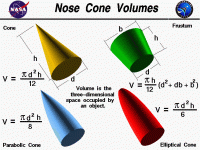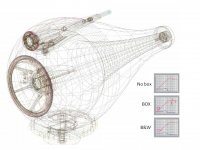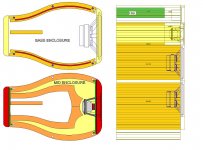I currently use BassBox for enclosure design, however, the latest project will utilise an egg-shaped (ellipsoidal?) enclosure. BassBox can accommodate a multitude of shapes, but alas, not this one. As the front and rear of the shape are flat, it is not entirely an egg-like form, but most closely resembles the midrange section of this well-known Bowers and Wilkins design.
What software can accommodate this shape, or minimally, allow me to convert the a given box fb dimensions into this form?
What software can accommodate this shape, or minimally, allow me to convert the a given box fb dimensions into this form?
What are you trying to model; inside the box or outside the box?
LEAP-5 would probably do that. I have not looked at all the details, but SoundEasy seems to be very robust and may be a rational choice.
However, what are your goals? You can get most of the things you need with simple hand calculations. Internal volume is pretty much the same regardless of cavity shape.
It used to be an advantage to make walls non-parallel to reduce standing waves, but even modest stuffing does 99% of the work. So the gain is minimal.
Externally you have diffraction. However, there are simple things that will reduce that effect with just about any shaped enclosure.
In the end you will have to at least build a prototype to see if your modeling was correct, so I usually don't get too wound up trying to produce an uber accurate model because the proof of the pudding is when you measure the real thing.
LEAP-5 would probably do that. I have not looked at all the details, but SoundEasy seems to be very robust and may be a rational choice.
However, what are your goals? You can get most of the things you need with simple hand calculations. Internal volume is pretty much the same regardless of cavity shape.
It used to be an advantage to make walls non-parallel to reduce standing waves, but even modest stuffing does 99% of the work. So the gain is minimal.
Externally you have diffraction. However, there are simple things that will reduce that effect with just about any shaped enclosure.
In the end you will have to at least build a prototype to see if your modeling was correct, so I usually don't get too wound up trying to produce an uber accurate model because the proof of the pudding is when you measure the real thing.
To answer, I'd be interested in both internal and external dimensions. How does one calculate internal volume for an egg-shaped enclosure (with flat front and rear of differing circumference) by hand? Obviously maths/geometry are not a personally forte on my end, but one can assume simple boxes and spheres are much easier to calculate.
To answer, I'd be interested in both internal and external dimensions. How does one calculate internal volume for an egg-shaped enclosure (with flat front and rear of differing circumference) by hand? Obviously maths/geometry are not a personally forte on my end, but one can assume simple boxes and spheres are much easier to calculate.
Use a CAD drawing program and let the program calculate the internal volume. This is free and probably will do that:
Autodesk 123D - Free 3D Modeling Software, 3D Models, DIY Projects, Personal Fabrication Tools
Yes LEAP EnclosureShop will do all that you are asking. It has many standard volume shape definitions in the library. If you choose eggoid for example it starts by asking for three dimensions and calculates a shell and a chamber volume based on what you call out for shell thickness. You can then begin to modify the shape, place flat sutfaces, place sources of radiation anywhere on the surfaces and go to town on driver integration and diffraction modeling and much more.
EnclosureShop is not a cad enclosure design program however. You can import a 3D definition for the shell of any enclosure but the volume cannot be calculated by the program, not important for a shell, necessary for a chamber though. Also EnclosureShop approximates 3D shapes by tessellation of flat polygons but it is a modeling program, not AutoCad or SolidWorks.
To date it's the most powerful and accurate program I have used and at $800 USD or what ever it costs now it's a bargain if your serious. We spend way more than that on drivers anyway.
EnclosureShop is not a cad enclosure design program however. You can import a 3D definition for the shell of any enclosure but the volume cannot be calculated by the program, not important for a shell, necessary for a chamber though. Also EnclosureShop approximates 3D shapes by tessellation of flat polygons but it is a modeling program, not AutoCad or SolidWorks.
To date it's the most powerful and accurate program I have used and at $800 USD or what ever it costs now it's a bargain if your serious. We spend way more than that on drivers anyway.
You can estimate the volume of a truncated sphere with this equation:
r is the radius of the cabinet sphere
x is the radius of the front speaker baffle hole
The rear tapered tube volume is not calculated.
PI * r * 2*x + 2/3 * PI * r^3 - 1/3 * PI * x^3
For
r = 10" interior radius of sphere
x = 4" radius of 8" speaker baffle cut out
volume = 3285 cu in = 1.9 cu ft = 53.8 cu liters
1 cubic foot = 28.3168 liters
r is the radius of the cabinet sphere
x is the radius of the front speaker baffle hole
The rear tapered tube volume is not calculated.
PI * r * 2*x + 2/3 * PI * r^3 - 1/3 * PI * x^3
For
r = 10" interior radius of sphere
x = 4" radius of 8" speaker baffle cut out
volume = 3285 cu in = 1.9 cu ft = 53.8 cu liters
1 cubic foot = 28.3168 liters
@LineSource
Thanks, although the tapered tube in the design I'm considering is somewhat more voluminous and would have an impact. Would the above formula still be appropriate?
Figure attached with equations for common cone volumes.
If you follow the B&W sphere+tapered_tube research, the exit to the cylinder shaped tube has a entry diameter pretty close to the diameter of the speaker cone.
Attachments
- Status
- This old topic is closed. If you want to reopen this topic, contact a moderator using the "Report Post" button.
- Home
- Loudspeakers
- Multi-Way
- Enclosure software for odd shape


